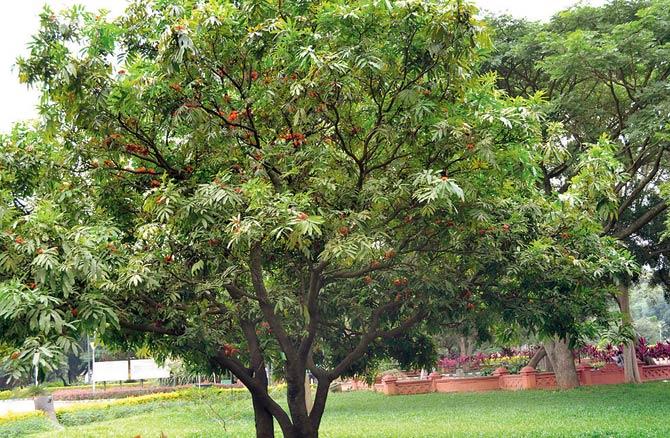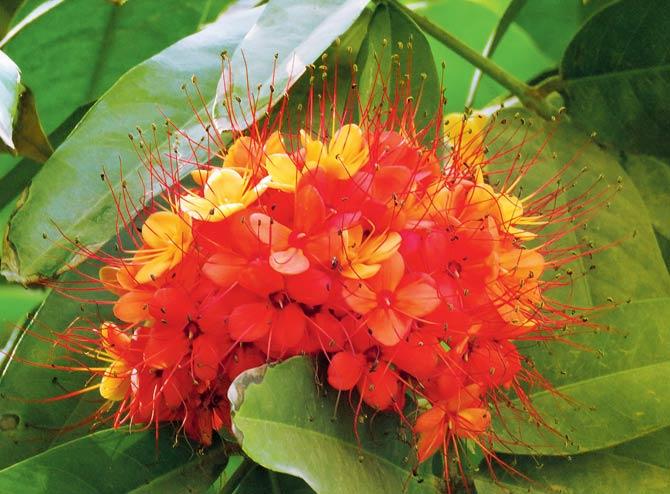Kolkata is touted as the City of Joy while Mumbai has been relegated to the City of Dreams

 Kolkata is touted as the City of Joy while Mumbai has been relegated to the City of Dreams. But, I can guarantee that when you have two different species of the Sorrowless, Happiness or, what is popularly called the Ashoka tree, thriving in Mumbai, you can only be a happy citizen.
Kolkata is touted as the City of Joy while Mumbai has been relegated to the City of Dreams. But, I can guarantee that when you have two different species of the Sorrowless, Happiness or, what is popularly called the Ashoka tree, thriving in Mumbai, you can only be a happy citizen.
The word Ashoka can be broken down to mean A (lacking) and Shoka (sorrow), thus referring to the lack of sorrow or the lead up to happiness. It is no wonder then that even in mythology, this tree finds a mention in the Ramayana, where Ravana after kidnapping a pregnant Sita, makes her reside in a grove of Ashoka trees. The bright orange-red flowers of the Ashoka were meant to keep her calm and happy, and its evergreen leaves provided cool shade. In effect, the tree kept Sita’s twin foetuses (Luv and Kush) healthy. Sita had apparently met Hanuman in Ashoka van, which is the forest of happiness.
ADVERTISEMENT

To my delight, our so-called over-concretised Mumbai, boasts of both varieties of Ashoka trees the true or Sita Ashoka (Saraca indica) and the False Ashoka (Polyalthia longifolia) or Asupalav meaning the tear-leaved tree. What we see lining the boundaries of most housing colonies, municipal schools and even along some avenues, are the lollypop-like tall Mast trees, with wavy, dark green pointed leaves. The tall poles of the tree were used to make masts of sailboats (thus the name).

They got planted due to their evergreen nature and the fact that they look a bit like the Sita Ashoka trees. The Mast trees are known to be utilised by a few bird creatures, such as the tailed jay butterfly (host plant), koels, crows and flying foxes (food) and white-breasted waterhens (nesting). The Asupalavs were popularly planted to cut noise pollution along avenues in India, Sri Lanka and Indonesia. Their jade coloured flower clusters are rarely known to people. The leaves are used wrongly to replace true Ashoka and mango leaves during pujas and to adorn doors of homes during festivals. Unfortunately, the fir-like long stems of the Asupalav tend to break during high winds, making them an ill-advised option for a city like Mumbai.
In contrast, the Sita Ashoka, also called Madhupushpa, is a slow-growing, short evergreen rainforest tree, which grows in riverine and higher altitude regions of the Western Ghats and the Deccan Plateau. It has dense clustered leaves, which are plastic-like and bright pink when young. The bright orange-yellow flowers fill the entire tree from February to April.
Instead of the false Ashoka, the city should consider planting the Sita Ashoka. In Sanjay Gandhi National Park, I have seen rare racket-tailed drongos and emerald doves make their nests in the notches of the Ashoka tree. The flat pods are consumed by langurs and squirrels. Many butterflies including the blue mormon, recently declared Maharashtra’s state butterfly, the common wanderer and the great orangetip, can be seen sucking nectar from the fragrant flowers of Sita Ashoka.
The period between July 1 to 7 is designated as Van Mahotsav across India and people from Maharashtra are seen undertaking tree plantation drives. The Sita Ashoka, or the true Sorrowless tree, is worth considering. Remember that it wasn’t without reason that as early as 2nd century BC, most temples across India have depicted sculptures of Yakshis or mythical beings stand under the branch of an Ashoka tree, as a symbol of fertility, prosperity and happiness.
 Subscribe today by clicking the link and stay updated with the latest news!" Click here!
Subscribe today by clicking the link and stay updated with the latest news!" Click here!







